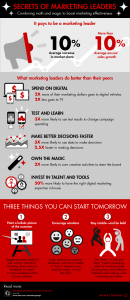— October 31, 2017

Natalia_Kollegova / Pixabay
What do you do when your agency growth hits a plateau and you feel stuck?
A client recently asked for help on this very topic. He had been running his agency for a decade—and sales were in a slump. He felt that he had a good team doing good work, and they specialized in a particular technology where they’d developed strong expertise.
He had even raised their hourly rate—in fact, it was the highest rate that I’ve seen for that particular technology level so far. But they just weren’t seeing any growth.
What can you do if you hit slower growth or a plateau? Read on—this is a long article but there’s a lot to cover to help you turn things around!
What factors lead to agency growth?
Business growth is no simple feat. There are are a lot of factors that go into helping an agency grow initially, and it only gets more complex the longer the agency is around.
Agency growth requires at least 8 things:
- Strong sales pipeline, to keep new work coming in.
- Strong client onboarding, to get new clients started smoothly.
- Strong project management, to complete the work profitably.
- Employer-of-choice reputation, to attract flow of employees (and freelancers) to do the work.
- Regularly-evolving team structure, to keep up with the need to scale the team.
- Strong culture and clear vision, to keep people on the same page.
- Cash reserves, to cover speed bumps along the way.
- Luck.
But what is growth? Before we can go further, we need to agree on a few terms.
Revenue vs. Profitability: What is growth?
First, let’s take a look at how we measure things. When most agency owners talk about agency growth they’re referring to revenue—and when they say they’ve hit a plateau, they mean that they can’t grow their revenue beyond a particular point.
Often, it can be more helpful to look at profit margins or absolute profits when trying to measure agency health. After all, if your revenues are flat but your profit margins are increasing, you’re taking home more money, and that’s a good thing, especially since you’re getting that done with the same amount of work.
And, of course, it’s possible for the reverse to be true. I often see agencies where profit margins decrease as revenue grows, because expenses grew even faster than revenue.
So, keep profitability in mind—but since most agency owners equate growth with revenue, let’s focus for now on revenue.
What do you do when revenues are flat? What do you do when you’ve hit a growth plateau?
Start by accepting that you’re going to have to make some changes. Whatever you’re doing now isn’t working. You’re going to have to let go of whatever approach or strategy you were using before. Once you’ve done that and you’re ready to move on, here is a list of things you can focus on to increase your revenue.
Spur agency growth by increasing your billable ratio
If your goal is to get higher revenue with your existing team, you can increase their billable ratio. What percentage of their time are they billing?
I see many agencies whose teams are only billing 30% of their time—this is leaving a lot of money on the table. An agency focused on growth should be billing at least 60% of its time on average.
Your calculation should include non-billable people, and non-billable time by otherwise billable people. It’s the fastest way you can increase agency growth—bill more of your existing time.
Check that you’re not working for free
As you calculate your billable ratio, you may find revenue is flat while hours are up. This means you’re making less money per hour worked. Or to put it another way, your agency is working for free.
I’m not opposed to doing work that’s strategically free, but if your team is giving free work to clients without your choosing to make it happen, that’s a problem (and, unfortunately, it’s a fairly common one).
This happens when project management and sales expectations aren’t in alignment.
If you’re working on a fixed-bid basis, it’s probably caused by spending more time than you estimated on the work. That means you need to create better estimates during your sales process by getting input from project managers and subject matter experts (SMEs) before your salesperson gives the quote to the client.
If you run into problems that are legitimately unforeseen circumstances, you need to learn from them and estimate projects better in the future. Doing a post-project debrief can help.
The exception here is around doing new types of work—the first time you do any type of project, your estimates are going to be pretty far off, and that’s okay as long as you learn from it.
Raising your rates as a way to increase agency growth
The second way you can increase revenue at your agency is to raise your rates. This is usually the first thing most agency owners think of… after all, raising your rates can help you make more money.
If you’re currently charging $ 125/hour now, and you raise your rate to $ 150/hour, your revenue will go up—it’s a formula. But there’s a caveat to that.
When you raise your rates, you risk losing clients. This is not necessarily a bad thing. I was director of client services at an agency that raised its rates 30%. I was the person who developed the program and rolled it out; I was telling people that their rates were going up.
You usually end up getting rid of the clients that you liked working with the least, the clients that didn’t enjoy paying you money, and didn’t really appreciate your help—good riddance.
However, raising your prices means you risk losing some of the clients you’d prefer to keep.
If you’ve got clients doing a certain amount of work at a certain rate, odds are at least some of those clients will cut back when you raise your rate. Fewer hours or fewer projects at a higher rate means you may end up bringing in less revenue.
This can be a blessing in disguise, since it can lead your team to provide better attention to these smaller pools of clients, allowing you to more effectively upsell them and bring in new business that way, again leading to growth—and this time with just those clients you actually enjoy working with.
Upselling your way to agency growth
You are actively upselling your current clients, right? To be clear, upsell does not have to be a dirty word. You should not be pushing clients to do work that they don’t need—that’s not an upsell; that’s just being sleazy.
An upsell is identifying an opportunity that the client will benefit from, that the agency can help them implement on a paid basis.
For instance, a client comes to you for a new website and you pitch them on doing a logo redesign. Or maybe you start doing the website and find they’re running into delays on getting the content done, so you offer to provide content services.
The most traditional upsell is getting a change order on an existing project for new features or new capabilities.
For instance, I was a PM at an agency helping a client create an aggregator for team members’ offsite blogs. This let everyone on their team post from different places and everything would appear in one place, in line with the organization’s decentralized approach.
The original plan was that just one person would be an active blogger on the main site. Once the project got started and the client saw what they could do with the new site, everyone on their team wanted access.
This was clearly outside the scope of the original project. But the client wanted it, and we could do it. So I asked, “Would you like an estimate on that?” He said yes; after receiving it, he approved the new scope and signed off on the change order.
Everyone was happy. They got what they wanted, the agency got paid to do more work, the site was better, and in the end, the upsell worked.
If your agency is not looking for upsell opportunities and then asking for those additional projects, you’re leaving revenue on the table, and that could be contributing to the growth plateau.
New revenue from new clients
Speaking of bringing in new business, that brings us to your next option for increased revenue: bring in new clients.
Taking care of your existing clients is very important, and upsells and repeat business are a great way to grow revenues without having to hard sell every dollar. But focusing on a standard group of long-term clients can lead to complacency and stagnation.
If you have a client that’s been a client for years, and they’ve grown to more than 20% of your revenue, that’s all well and good. But what happens when they get acquired by another company or your primary contact gets fired, promoted, or moves across the country to a new job? You have a Client Concentration problem.
If you’re not bringing in new work, odds are your revenues won’t be growing much—and you may be leaving your agency at risk, should an existing anchor client leave.
Of course, if you’re bringing in new work, odds are you’ll also need to increase your production capacity. That means bringing on more team members…which means an increase in expenses. Again, you’ll need to find the right balance between growing your team and growing your revenue.
What role does positioning play in agency growth?
Your agency’s positioning and profile also plays an important role in your growth (although less direct). If your agency is regarded as a specialist in what you do and where you do it, you’re likely to have lots of people seeking to do business with you.
This means that you can be more selective about the clients you see, you can do higher profile projects, you can do higher margin work, and you can work with clients that you want to work with rather than clients you have to work with.
That selectivity doesn’t directly translate into revenue growth, but working with clients you and your team don’t like doesn’t help when it comes to growth plateaus.
After all, it makes sense that your team won’t seek-out opportunities to do more work for clients they hate. It’s like the old joke about people making partner at a law firm—it’s like winning a hot dog eating contest, where the prize is… more hot dogs.
If you’ve hit a plateau, look at the types of projects you’re doing and the quality of the clients you’re working with. Does redefining your positioning make sense?
A deeper look at project types (and the impact on agency health)
When reviewing the types of work you’re doing, it’s also worth evaluating the balance between stand-alone projects and recurring revenue.
The ideal model is to work with clients on a recurring basis. This could mean working with clients who start on a recurring basis (whether that’s a retainer or service package up front) or starting with a project-based approach, earning your clients’ trust, and winning their business as a recurring client after that first project is done.
However, you don’t want to become overly reliant on any one specific client. As I mentioned earlier, having any client make up more than 20% of your revenue leaves your agency at risk.
It’s also important to consider the size of the projects you’re taking on—are they small projects or large ones?
If you’re doing only big projects, you’re at the mercy of large clients making decisions, people who don’t care about your need to get going on things so you can bill for work that you planned on.
If, on the other hand, you’re just working on small projects, it’s easy to get scattered and drawn in a million different directions trying to take care of everyone’s needs. A large number of small clients requires more client service time than a smaller number of big clients with the same revenue.
The ideal is a combination of both. Several large engagements will help you focus your client service efforts, while smaller engagements will help you fill in any downtime. If one of those large projects is paused or you’re waiting for client feedback, the smaller projects keep the revenue coming in.
…And maybe a plateau isn’t such a bad thing.
Before undertaking any of the tips above, you should also think about what breaking a growth plateau means for you and for the agency.
If you’re overwhelmed with work and need more people to get the work done, then think about whether you want to be hiring and managing more people. You’ll be responsible for a larger payroll and for managing more people (or managing the people who manage those people).
Is that what you really want? It depends on the type of agency you want. For an owner who wants a high-growth agency, the answer is often “yes.” But for an owner who wants a lifestyle agency, maybe not.
The right path for your agency always depends on your individual values, goals, and resources.
If the solution is to increase your billable ratio and bill more of your agency’s time, are you ready to hold employees more accountable? They’re not necessarily going to enjoy getting pushed to be more billable; nobody likes being told they need to work harder.
And if the solution involves firing some of your clients and looking for new ones (ideally finding those new ones first), are you ready for that? Are you ready to be out there selling? Are you ready to have some very difficult conversations with clients—including, possibly, some long-time clients? It’s worth considering.
A growth plateau is not necessarily bad—if it’s supporting the type of agency you want.
Question: How have you handled an agency growth plateau at your firm?
Business & Finance Articles on Business 2 Community
(64)
Report Post



